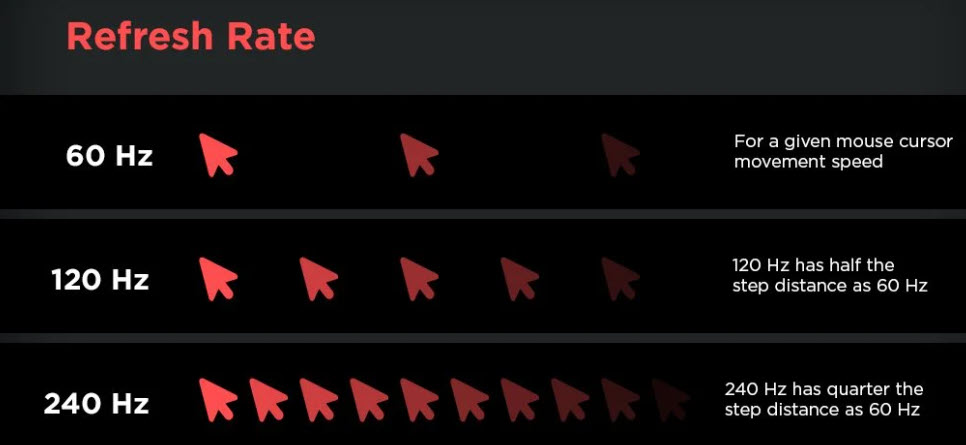When it comes to immersive gaming, we’re all after that seamless, ultra-responsive experience. But is a 60Hz monitor enough to meet our high-octane gaming needs? Let’s dive into the world of refresh rates and find out if 60Hz can truly keep up with the fast-paced action.
We’ve seen a lot of debate around refresh rates in gaming circles, and it’s time we sorted the facts from the myths. Whether you’re a casual gamer or a competitive player, understanding how a 60Hz display affects your gameplay is crucial.
Join us as we explore the impact of 60Hz on gaming performance. We’ll break down the technical jargon and give you the lowdown on whether 60Hz monitors are the hidden gems of the gaming world or if it’s time to level up.
Also Read: We discussed on our blog whether 70 Celsius is hot for GPUs while playing games.
Is 60Hz Enough for Gaming?
As an experienced computer gamer, while 60Hz is generally adequate for casual gaming, particularly for slower-paced games, or if you’re on a tight budget, there might be better options for competitive or fast-paced games. Higher refresh rates like 120Hz or 144Hz provide smoother visuals and can give a competitive edge in fast-paced games, where reaction times and fluid motion are crucial. Ultimately, the choice depends on the types of games you play and your personal preference for visual fluidity.
What is a refresh rate?
When we talk about a monitor’s refresh rate, we’re referring to the frequency at which the display updates with new images each second. It’s measured in hertz (Hz), which denotes cycles per second. A 60Hz monitor refreshes the screen 60 times per second, presenting a new frame for every slight movement or action taken in a game.
Higher refresh rates are typically associated with smoother motion representation. This means that as the refresh rate climbs, the potential for a more fluid gaming experience increases. Not only do objects appear to move more smoothly across the screen, but any actions you take via keyboard or controller may also seem more responsive.
However, it’s essential to understand that a monitor’s refresh rate is not the sole factor dictating gaming performance. It must operate in harmony with the game’s frames per second (FPS), which is the frequency at which your computer or console can process and present new images. If your game runs at more than 60 FPS on a 60Hz monitor, you won’t experience those extra frames visually. The monitor simply can’t keep up, essentially capping the FPS to the screen’s refresh rate.
Here’s a simple breakdown of some common refresh rates found in monitors and how they compare to a 60Hz standard:
| Refresh Rate (Hz) | Comparison to 60Hz |
|---|---|
| 60Hz | The standard baseline refresh rate for most monitors |
| 120Hz | Displays twice as many frames per second |
| 144Hz | Often favored for competitive gaming |
| 240Hz+ | Provides an extremely smooth gaming experience |
The importance of refresh rates in gaming
Refresh rates are vital in creating a smooth and immersive gaming experience. High refresh rates can lead to more fluid motion, making it easier for us to track fast-moving objects in action-packed gaming scenarios. This smoothness is particularly noticeable in genres where split-second decisions are critical, like first-person shooters or racing games.
Aside from enhancing visual fidelity, a monitor’s refresh rate could potentially influence our reaction times. Faster refresh rates translate to new information being presented more quickly on the screen, allowing gamers to respond to in-game events more rapidly. For competitive gamers, this can be the difference between victory and defeat.

For higher refresh rates to be truly effective, they must be complemented by sufficient processing power and graphics capability. This means having a GPU that can consistently push the necessary FPS to match the monitor’s refresh rate is key. Without the right hardware, even a monitor with a high refresh rate won’t improve gaming performance.
Pros and cons of gaming with a 60Hz monitor
When considering the advantages of a 60Hz monitor, we must acknowledge its affordability. These monitors are typically more budget-friendly, making them a great entry-point for gamers who are just starting to build their setups or those who have to adhere to a tight budget. Furthermore, a 60Hz refresh rate is generally sufficient for many popular game titles, particularly those that do not rely heavily on rapid motion, such as strategy games or casual simulations.
- Cost-effective for new or budget-conscious gamers
- Suitable for less demanding games
Moreover, 60Hz monitors are widely compatible with various hardware and games. They place lower demands on graphics cards, meaning that we won’t need to invest in top-of-the-line GPUs to hit the desired framerate, which is particularly beneficial for us if we’re working with older or less powerful components.
In terms of the cons, there are some limitations to 60Hz monitors that need consideration. With the advent of higher refresh rates, 60Hz may not deliver the smoothest gameplay experience for fast-paced games, such as first-person shooters or racing titles, where rapid movements and split-second reactions are crucial.
| Drawback | Reason |
|---|---|
| Limited smoothness in gameplay | Insufficient for fast-paced games |
| Reduced competitive edge | Diminishes performance in reflex-based genres |
We may find ourselves at a competitive disadvantage when up against opponents with higher refresh rates. As the gaming industry progresses, the standard is leaning towards monitors that offer quicker refresh rates, which can translate to a more immersive and reactive gaming experience.
It’s also essential to note that some newer game releases are optimized for higher refresh rates, and sticking to a 60Hz monitor could potentially restrict us from enjoying these games to their full extent. The evolving technological landscape suggests that while 60Hz monitors are competent, future-proofing our gaming setup may require considering monitors with higher refresh rates.
Is 60Hz good enough for casual gamers?
When it comes to casual gaming, 60Hz monitors are often considered a solid baseline. We’re looking at a scenario where the refresh rate is not the paramount feature because casual gamers typically prioritize enjoyability over competitive performance. Although higher refresh rates offer smoother visuals and can provide a competitive edge, the sheer pleasure of gaming can absolutely be experienced on a 60Hz display.
Most casual gamers indulge in games that don’t demand lightning-fast reflexes or ultra-high frame rates. For single-player games, story-driven adventures, and turn-based strategies, a 60Hz screen can deliver a satisfying experience. Here’s why:
- Visual quality: At 60Hz, you still get a smooth experience with minimal screen tearing, especially if the game’s frame rate is synced to the monitor’s refresh rate.
- Cost-effectiveness: 60Hz monitors are more affordable, making them a great choice for gamers on a budget.
- Compatibility: Older games or systems may not even support higher refresh rates, so in these cases, a 60Hz monitor is fully sufficient.
When we consider the demands of modern video games, it’s clear that not all titles are created equal in terms of their technical requirements. Many popular games run perfectly well at 60 frames per second, and since a majority of monitors support at least a 60Hz refresh rate, gamers can enjoy these titles without any significant issues.

It’s also worth noting that casual gamers might not be as sensitive to the differences between 60Hz and higher refresh rates. Visual fidelity, such as resolution and color accuracy, often takes precedence over the smoothness of motion for many casual players.
While it’s tempting to chase the specs of a high-end gaming setup, it’s crucial to consider what makes the most sense for your gaming habits and preferences. Does the investment in a higher refresh rate align with the types of games you love? Will you notice and appreciate the smoother gameplay? These are the kinds of questions that help us determine whether 60Hz is not just good enough but perhaps the ideal choice for casual gaming environments.
Is 60Hz good enough for competitive gamers?
When it comes to competitive gaming, frame rate can be just as vital as skill. For those striving for peak performance in fast-paced games, a 60Hz monitor can be a handicap. Competitive players often opt for monitors with higher refresh rates, like 144Hz or even 240Hz, which allow for smoother and more accurate motion representation.
A snappier refresh rate can spell the difference between winning and losing in scenarios where reaction time is critical. Let’s break down why higher refresh rates might be the deciding factor for gamers who play competitively:
- Input Lag: At 60Hz, a monitor refreshes 60 times per second. Transitioning to a monitor with a 144Hz refresh rate dramatically reduces input lag, which is crucial for games that demand precise timing and rapid responses.
- Screen Tearing: V-Sync, a feature designed to prevent screen tearing, can cause increased input lag on 60Hz monitors. Higher refresh rates mitigate this issue, allowing competitive gamers to enjoy a seamless graphical experience without the associated lag.
- Motion Blur: Clarity during fast movements is essential for tracking and targeting in competitive gaming, and higher refresh rates can decrease motion blur, providing a clearer visual experience during intense gameplay.
While 60Hz monitors are sufficient for casual gamers, the benefits of higher refresh rates are particularly pronounced among the ranks of competitive players. It’s not just the display technology that’s important; the graphics card plays a pivotal role as well. To truly harness the advantages of a high-refresh-rate monitor, one’s graphics card must be capable of pushing the corresponding number of frames per second.
Given the competitive nature of certain games, every advantage counts. We’ve observed that professionals in the eSports arena overwhelmingly favor monitors with refresh rates far exceeding 60Hz for their ability to deliver real-time visuals without delay. For hardcore gamers, the combination of cutting-edge hardware and optimized settings can be the winning edge they seek.
Conclusion
We’ve explored the nuances of monitor refresh rates and their impact on gaming experiences. For those of us who enjoy gaming at a more relaxed pace, 60Hz monitors serve us well, striking a balance between performance and cost. However, for the competitive gaming community, the pursuit of excellence means reaching for monitors with higher refresh rates. It’s clear that to stay ahead of the curve and maximize our in-game potential, investing in a monitor that goes beyond the standard 60Hz is a wise choice. Let’s remember to pair it with a capable graphics card to truly unlock the full gaming prowess of higher refresh rates.






